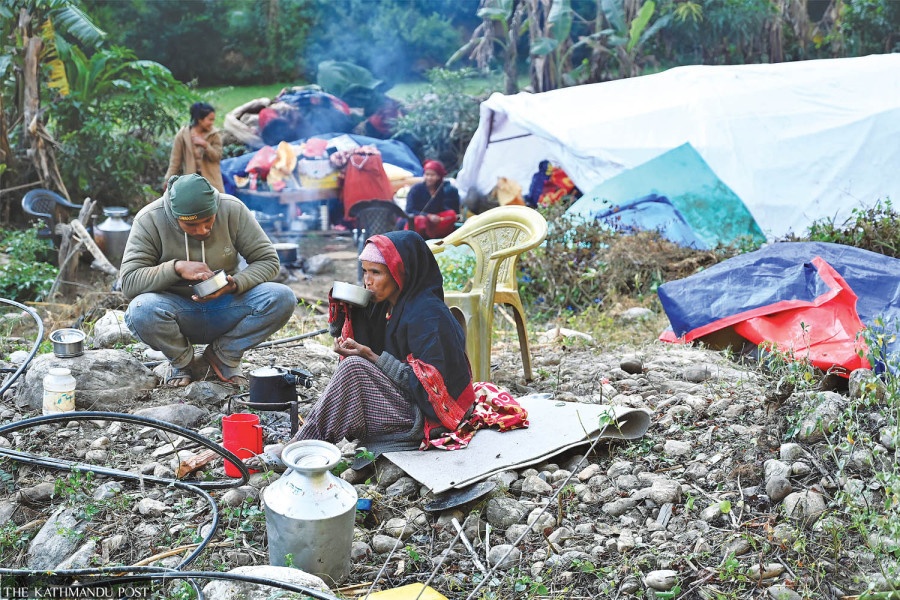Columns
Patchy relief: Lessons from Jajarkot
The question is how quickly and effectively emergency support reaches those in need.
Madhukar Upadhya
The first responders in any disaster events are always family members, neighbours and members of local communities affected by the disaster. They are the ones wading into the wreckage to pull survivors out, gathering resources and rudimentary relief materials and performing whatever first aid they can to save lives. And they do so without any real understanding of the scale or severity of the damage because lives are at stake, and time is of the essence. However, beyond that, the state and its mighty weight are needed to carry out further rescue and relief operations, particularly in situations requiring precision where negligence could be fatal.
The Government of Nepal has significantly improved its institutional and technical capacity to carry out rescue operations, particularly since the enactment of the Disaster Management Act in 2017. The response agencies now have logistics in place—from trained divers and firefighters to an inventory of the required equipment, as well as the ability to mobilise security personnel and administrators within a short period when needed—to effectively search for survivors and provide them first-aid and take them to hospitals. Sadly, relief distribution to disaster survivors contending with the trauma of destroyed homes, lost personal belongings, dead family members, and a loss of any sense of normalcy remains questionable—something which should worry all planners wary of imminent climate disasters.
Managing relief operation
We’ve seen the inadequate distribution of relief materials in every disaster event, including the recent earthquake in Jajarkot, which claimed the lives of 154 people. Around 9,000 households have been completely damaged while an additional 19,000 suffered partial damage, displacing approximately 12,000 families with winter just around the corner. With no roofs over their heads, the survivors desperately needed at least minimal relief to last them a few days until the trauma subsided. Unfortunately, they didn’t receive adequate relief as promptly as the rescue. Some complained that getting tarpaulins, blankets and food for the surviving members of the affected families was proving difficult with each passing day. In places where relief was distributed, the families felt discriminated against based on political lines and other affiliations. Some received relief twice, while others didn’t get it once in four days.
The local administration’s one-door policy to avoid problems of skewed distribution or duplication is a welcome step. However, the well-meaning policy delayed the distribution for days because of the administrative hurdles of getting approval from various levels, hurting the people for whom overwhelming support poured in from everywhere, including our neighbouring countries.
When it comes to reaching a large number of victims with emergency support, we undoubtedly lack institutions and managerial skills. A seemingly unrelated example is the spread of Lumpy Skin disease among cattle a few months ago. We didn't have the institutions nor enough technicians to administer the vaccines and medicine because of the sheer number of animals that needed to be treated across the country. As a result, over 48,000 cattle died within four months—a huge setback to the livestock owners.
Jajarkot’s lessons
There are vital lessons to learn from Jajarkot. We must improve our capacity for relief operations for the future because disasters of various kinds and intensities will be ubiquitous in our lives as a result of climate impacts. As the changing climate continues to bring more heavy rains, ferocious floods, killer landslides, flash droughts and widespread crop failures, experts tell us that adaptation efforts are reaching their limit, resulting in irreversible damage. The only way forward would be to help the victims reestablish their lives after disasters. The decision at the United Nations Framework Convention on Climate Change (UNFCCC) conference last year to establish a fund for loss and damage to support climate-induced disasters is exactly what it says on the box.
Now it's certain that some kind of dedicated fund will be established to support such loss and damage. Though it won’t be exactly what developing countries would’ve liked, the decision made during the last CoP to establish such a fund will finally materialise at the upcoming CoP28. The details are yet to be worked out and finalised in terms of the size of the fund, the designated eligible loss and damage impact and mechanisms to deliver them. While this is an excellent development that needs to be celebrated, there's a lot that we must do to prepare, particularly in light of how we handle relief operations.
According to the agreed principles, the support from the loss and damage fund must reach the neediest in an equitable, economic, climate-related, and gender-just manner and comply with human rights principles. For that, we need to be ready with national and sub-national systems equipped with policies, processes, guidelines and mechanisms to manage any support received from the loss and damage fund to address climate-induced disasters and their fallout.
One could easily say we can meet those conditions because we have been advocating for such criteria ourselves in our development works. However, Jajarkot, and many others in the past, lay bare our reality. Our methods are ad hoc, with very little to no regulatory oversight. Unfair and inadequate distribution of collected materials have plagued us for decades. The earthquake victims in Bajhang, another district in the areas hit by a 6.3 magnitude quake a month ago, have long stopped believing in promises made by the politicians during the disasters. This is yet another glaring example of how quickly disaster victims in remote places disappear from relief plans.
Meeting diverse needs
Disasters such as earthquakes, floods, fires, debris flows or flash droughts bring unimaginable sorrow, loss and agony. We must act quickly to comfort the disaster survivors in the initial days when their trauma is deep and often unbearable with the loss of loved ones. The question is how soon and effectively the relief or emergency support reaches the needy in a fair and equitable manner, considering the special needs of women, children, socially marginalised people, new mothers and individuals with disabilities and those living in remote places. We must begin focusing on the way we handle the distribution of relief in the shortest time possible to those who are forced to survive in the open sky, hungry and cold, in every disaster.




 15.12°C Kathmandu
15.12°C Kathmandu















